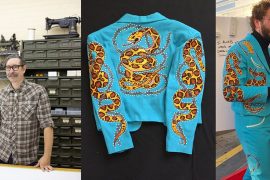Jerry Lee Atwood was working in a coffee shop over a decade ago when a regular customer loaned him a book on vintage western wear. At the time, Atwood was western-wear enthusiast who enjoyed doing hand embroidery. For fun, he hand-stitched small pieces, but had no clue what to do with them. “I started flipping through the book and seeing all these amazing western costumes with embroidery and rhinestones, and it got me all excited,” he says. “I thought this would be a great way to showcase my embroidery, but I didn’t really know how to sew.”
That deficit would have stopped most people in their tracks, but not Atwood, whose LinkedIn profile includes education credits from The School of Hard Knocks. He also studied at Herron School of Art and Design, but Atwood doesn’t mention that, perhaps because he finds self-study just as valuable. Determined to learn how to sew, Atwood dug in and trained himself by studying books and magazines.
By his own admission, his first projects left something to be desired. “I went to the fabric store and bought a basic western shirt pattern and some fabric,” he says. “I did a bunch of embroidery and made an awful western shirt, but I really enjoyed the process.”
Despite a disappointing start, he persisted. After the coffee shop closed and his job there ended, he picked up sewing work in a drapery shop, and eventually at the Indiana Repertory Theatre, where he designed and made costumes. It wasn’t long until he had mastered the nuances of custom tailoring and chainstitch embroidery, a technique he compares to painting with thread.
A glimpse of his portfolio proves how apt the comparison is. His work runs the gamut, from a portrait of a well-known Chicago tattoo artist to the face of a tiger, not to mention embellishments on western wear and other garments.
For people untutored in the ways of chainstitch, your nearest association with embroidery may be scanned images, made on digital machines. It’s a natural leap to make, but it misses the artistry behind Atwood’s work, which is done on vintage and antique machines. He owns nine, including his favorites, a French-made Cornely Model K and a Singer 114w103.
Chainstitch embroidery originated during the Victorian era, and remained popular through the 1960s. Imagine the embroidery on old varsity jackets, bowling shirts and work wear, and you get an idea of the three-dimensional look.
“Back in the day, there were people who trained and apprenticed to use these machines,” Atwood says. “Eventually, a lot of the machines fell by the wayside, and they just sat in the corner gathering dust until people like me started to uncover them.”
Once discovered, the machines presented their owners with a formidable obstacle. There aren’t many people alive who know how to operate and maintain them. For that reason, owning a chainstitch machine requires some grit. “I do know a few people who worked on them in the 1970s who’ve shared tips, but it’s definitely a skill that takes a long time to master,” Atwood says.
To solve that problem, Atwood and a few peers scattered across the U.S. have formed a tight, informal network. In fact, Atwood started an online forum to help artists share the mechanical knowledge they’ve gained from tinkering. They also push each other to higher levels of artistry by sharing their work.
What makes chainstitch unique is the obvious hand of an artist in every work. Unlike digital machines that make designs with coordinates, chainstitch artists work from freehand sketches transferred to fabric by wax transfer or chalk. “With digital embroidery, you scan the image and it’s going to look the same no matter who does the embroidery,” Atwood says. “In chainstitch, the same work could be done by four different people and you would see the texture and individual style of each artist.”
Today, the once obscure art is enjoying a renaissance among designers who want to embellish their clothes with the distinctive look of chainstitch. To wit: Billy Reid’s 2015 menswear collection featured chainstitch embroidery. The renewed interest permitted Atwood to quit his job and work full-time doing custom tailoring and chainstitch embroidery, most of which stems from orders outside the Indianapolis area.
“I’ve been really fortunate to make the right connections and find ways to get exposure,” Atwood says. “The people who really want chainstitch will find you, and they are willing to pay for it.”
One of his biggest breaks came from Nudie’s Rodeo Tailors, an iconic brand that had been in decline since the founder died in 1984. Founded in the 1930s by Nudie Cohn, a Russian immigrant, Nudie’s became famous in the 1950s for the custom western wear worn by the likes of Roy Rogers, Dale Evans and Elvis Presley.
More recently, Mr. Cohn’s granddaughter Jamie Nudie revitalized the brand with the help of Jess Hannebutt Snell, a former Indiana resident and friend of Atwood’s. “I knew Jess before she moved out to Los Angeles and started working with Nudie’s,” he says. The two became friends when Snell was designing her own Rockin B line of clothing, a mix of rockabilly and western wear.”
When Snell landed at Nudie’s, she tapped Atwood to help. “It’s hard to find people who can do chainstitch, and all of Nudie’s stuff was covered in it,” he says. “I did a few pieces for them and that was the start of the relationship with Nudie’s, which has been really great.”
Although he enjoys making custom western wear, Atwood’s first love is chainstitch embroidery. Finding sewing-related work was once a struggle, but today, Atwood gets two to three solid leads a day, mostly through his Instagram account. “That’s been an invaluable tool for artists and crafts people to get more business,” Atwood says. He also sells directly through Etsy.
His path to success is a lesson to aspiring artists and designers who lack start-up capital: with the right amount of nerve and desire, you can bootstrap a business. Atwood kept his day job as long as he could, which allowed him to finance his business while he was still working for others. “I never wanted to owe anyone or have a loan to pay back,” he says. “I sunk any spare money I had into machines, fabric and thread. For me, that’s been very freeing because I didn’t have the burden of a loan.”




